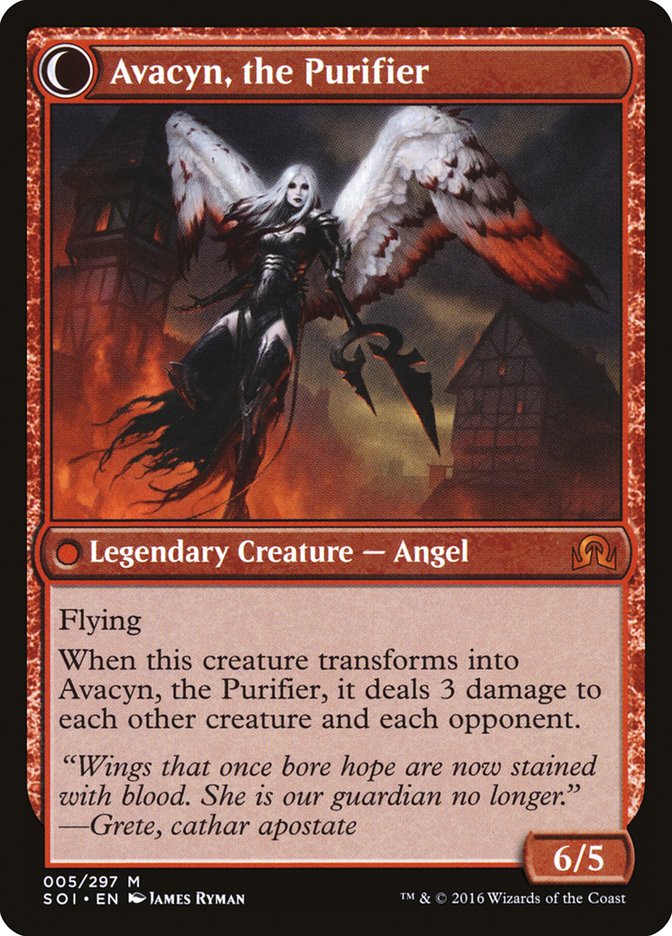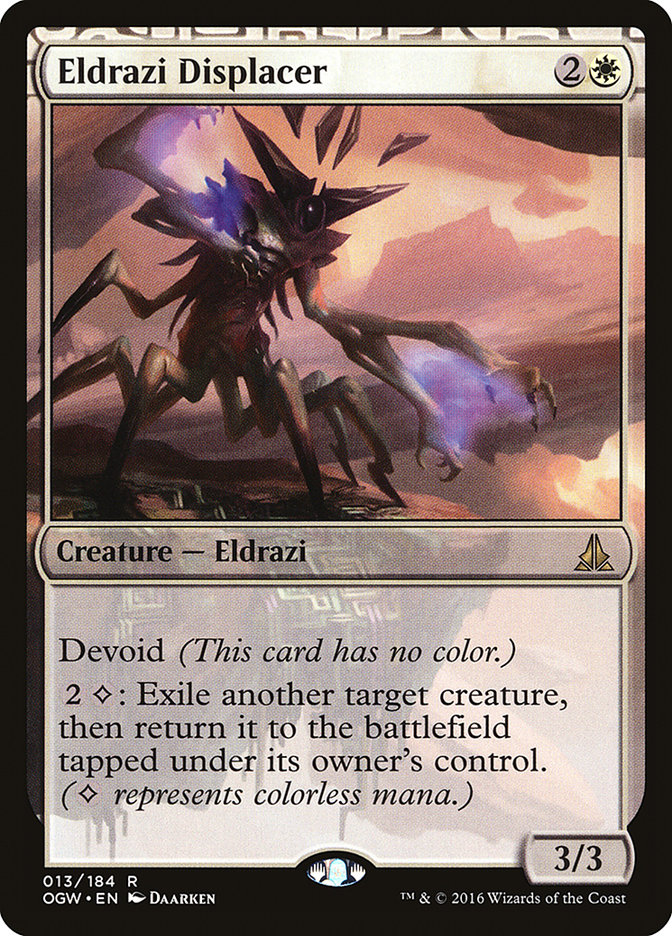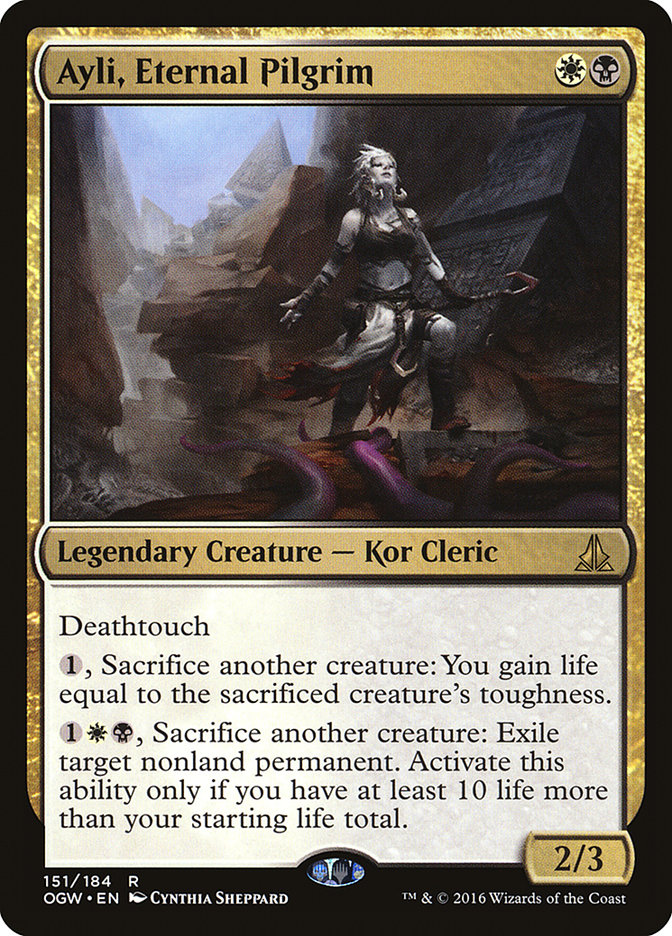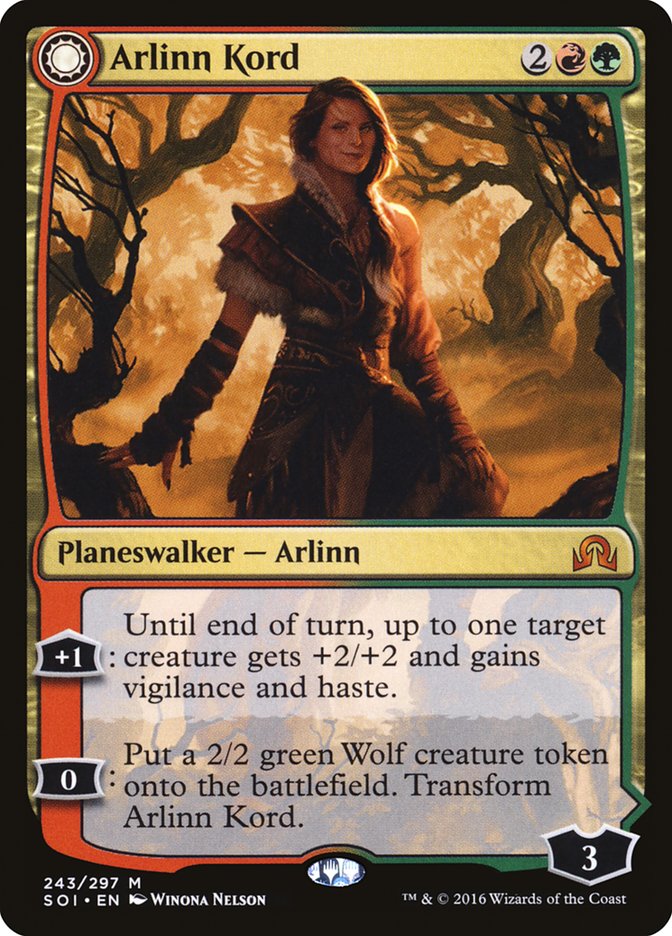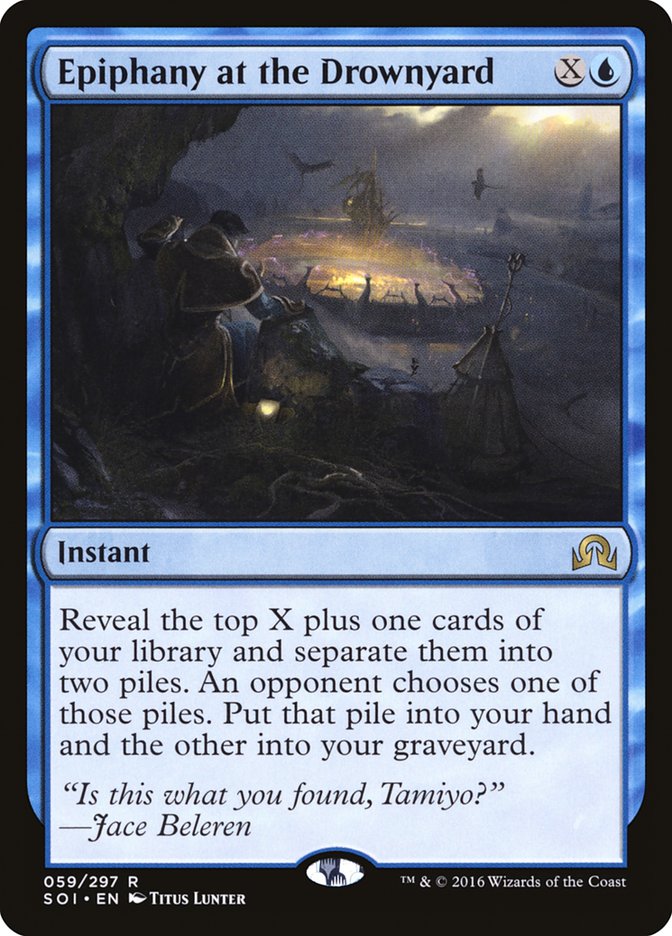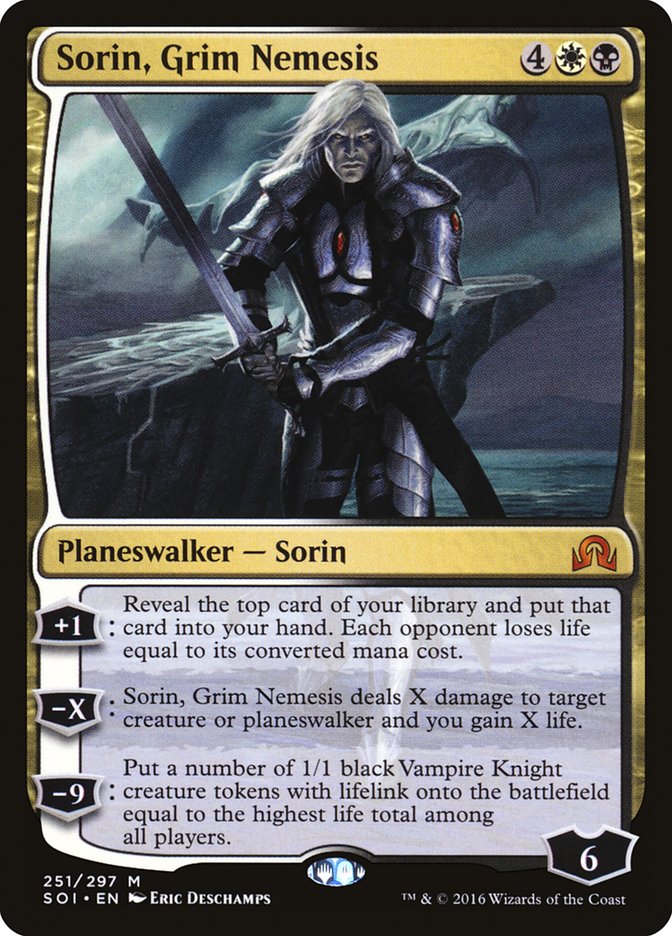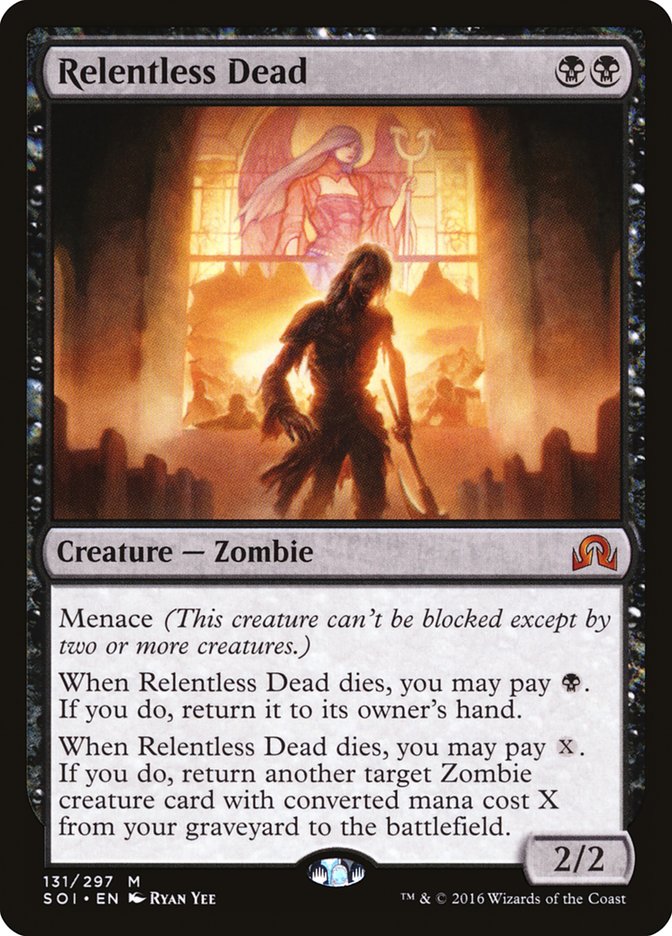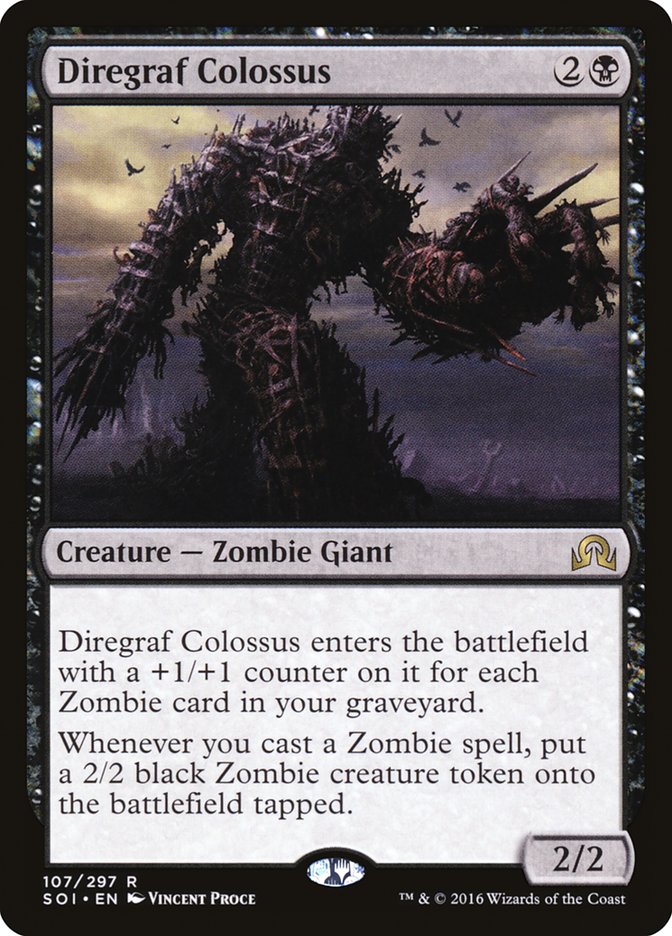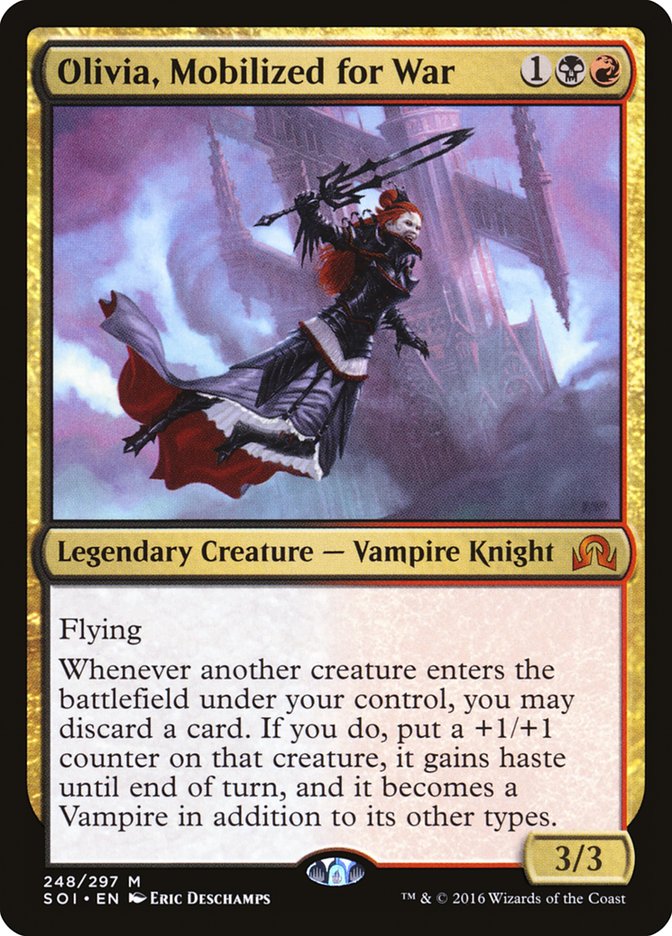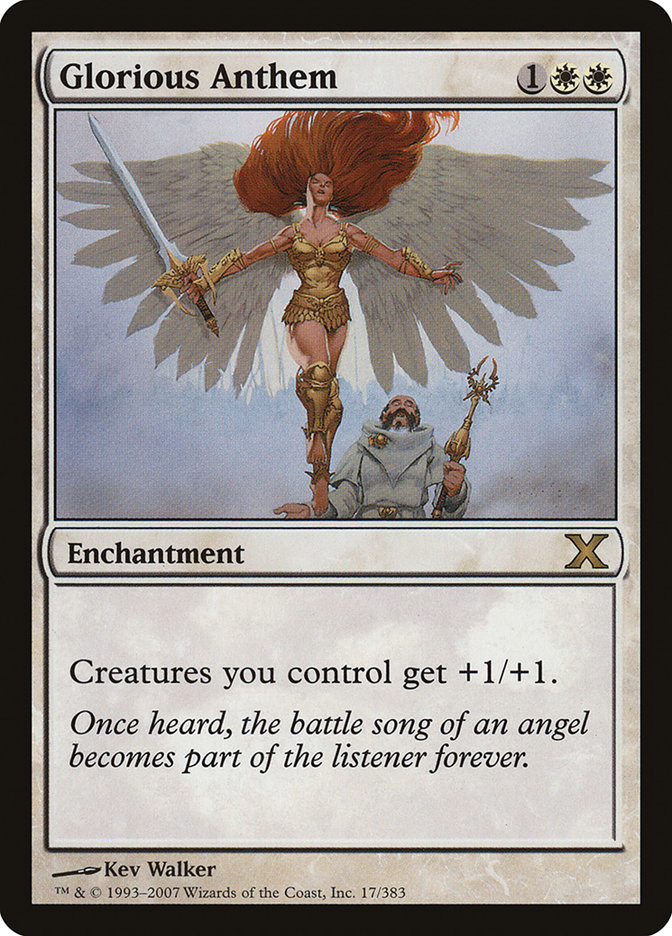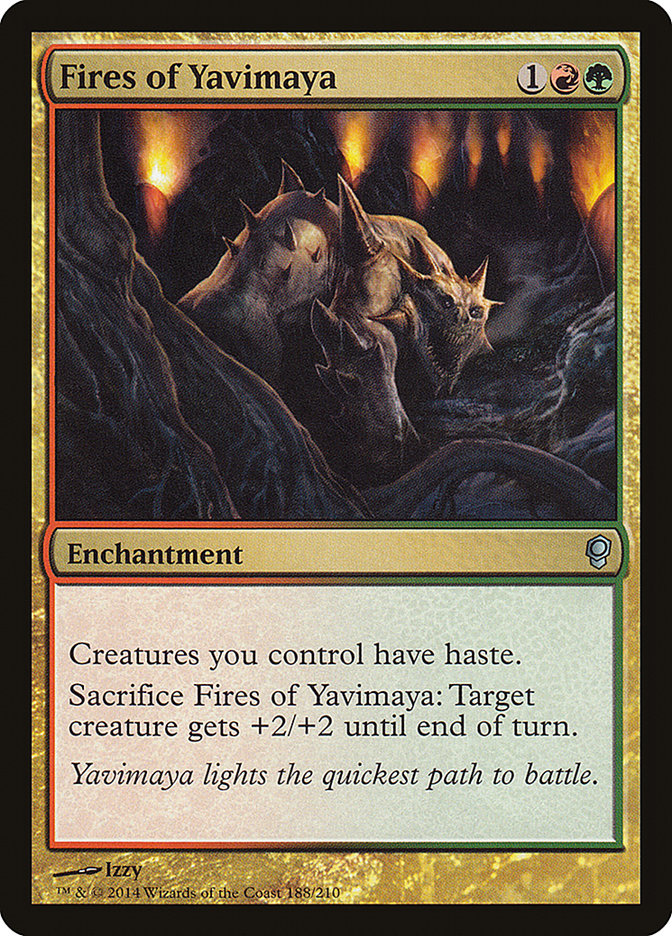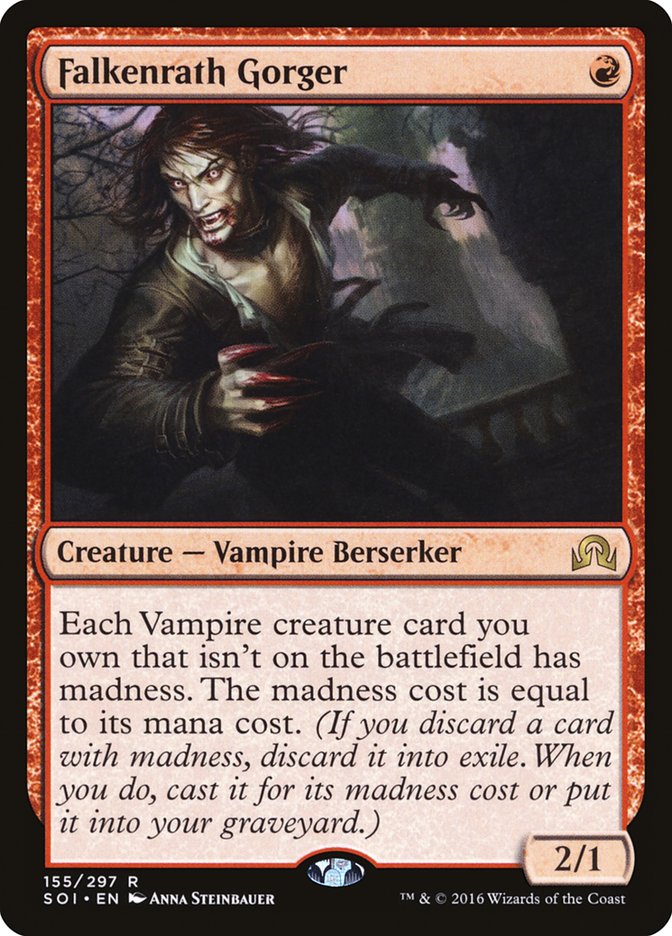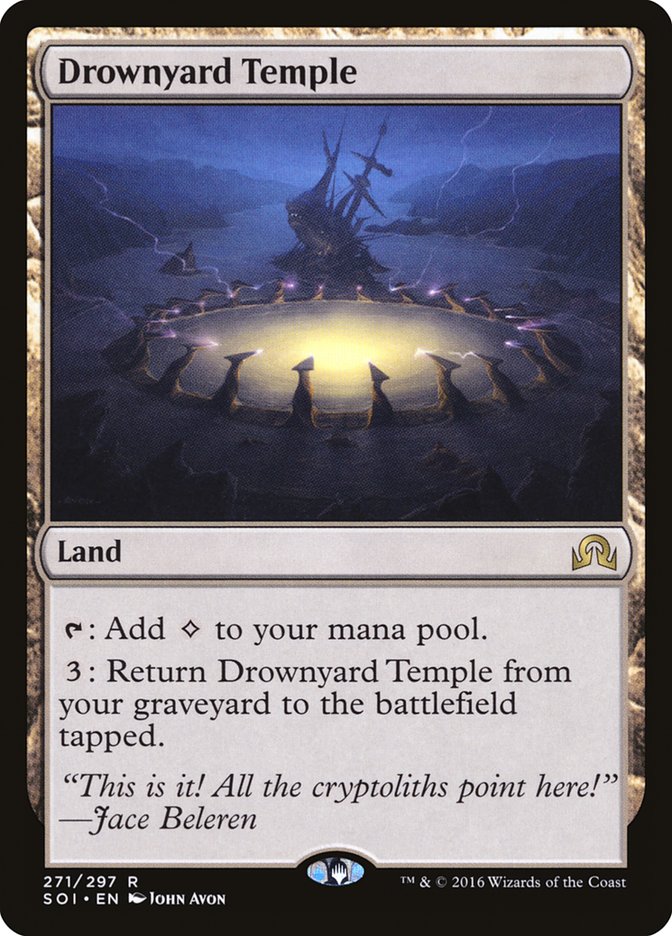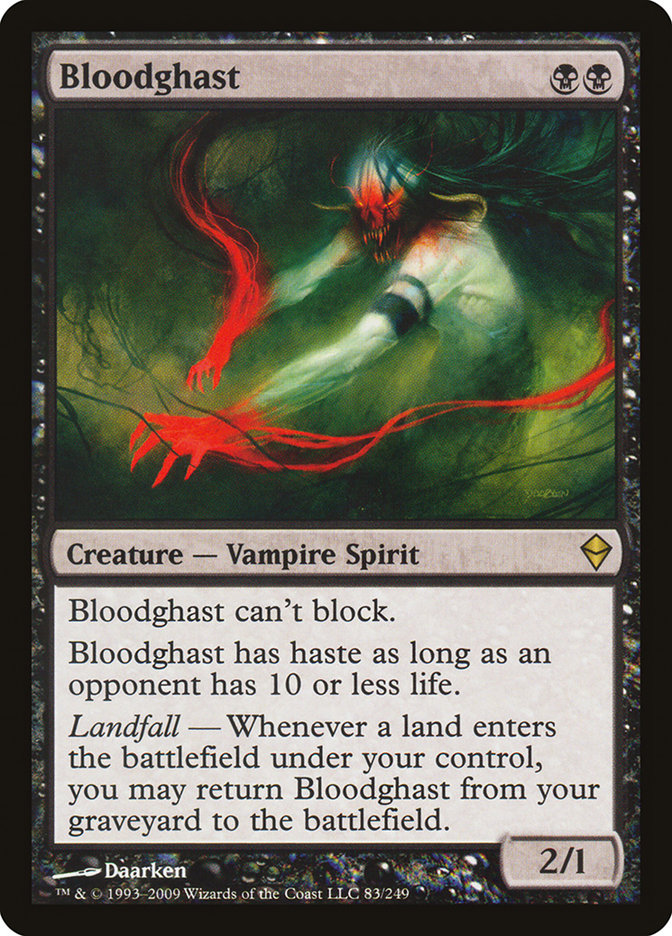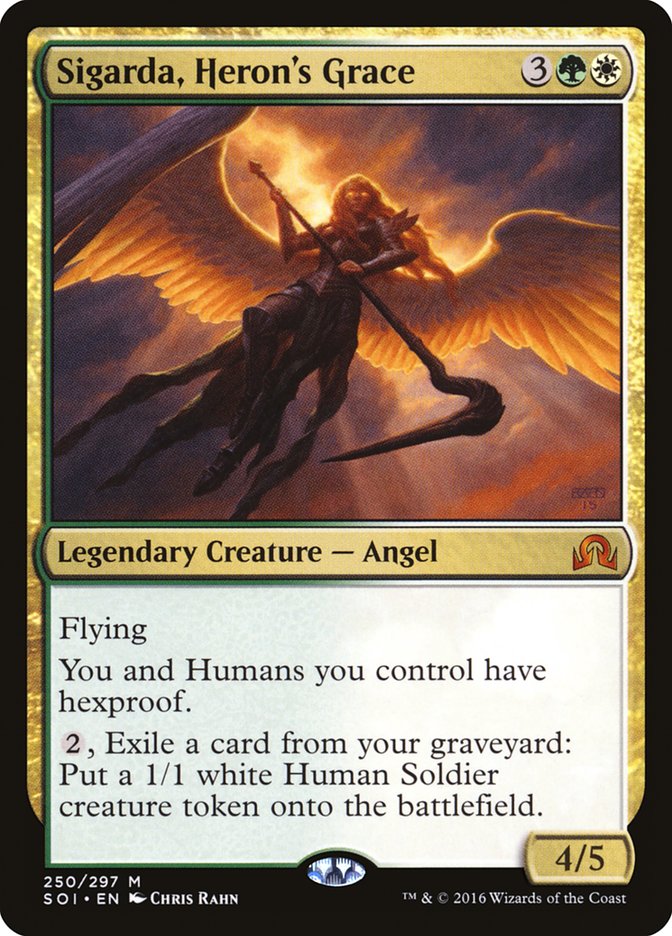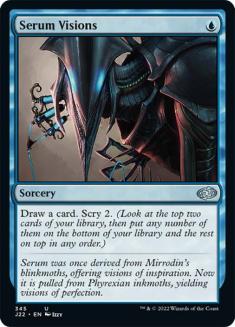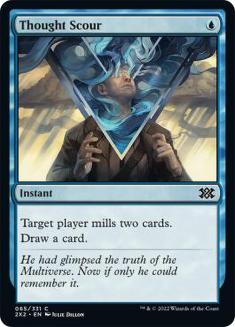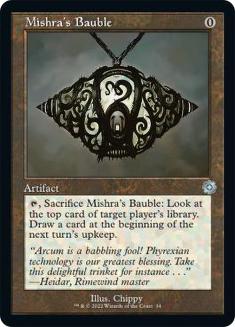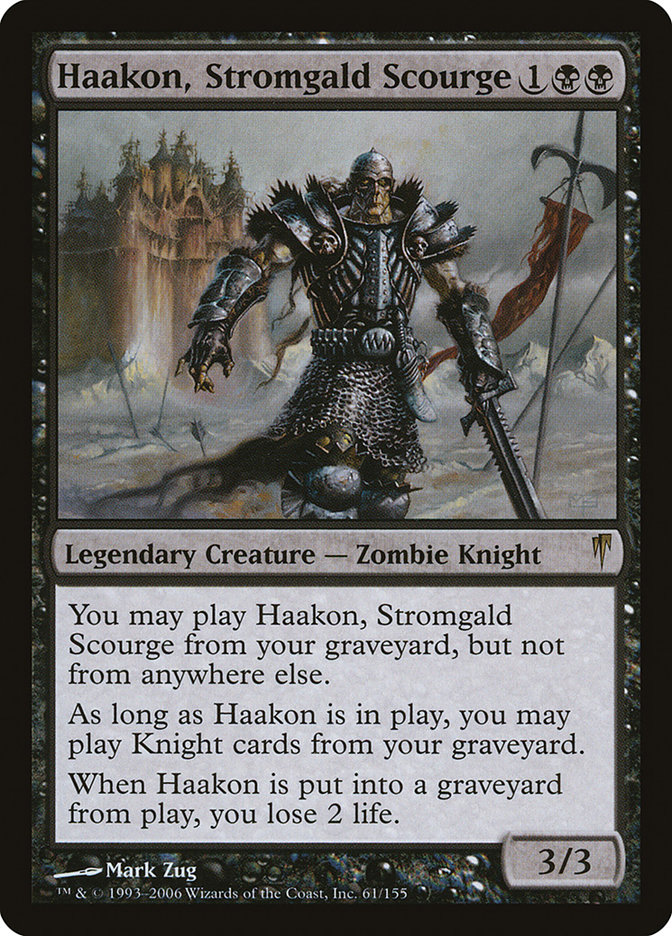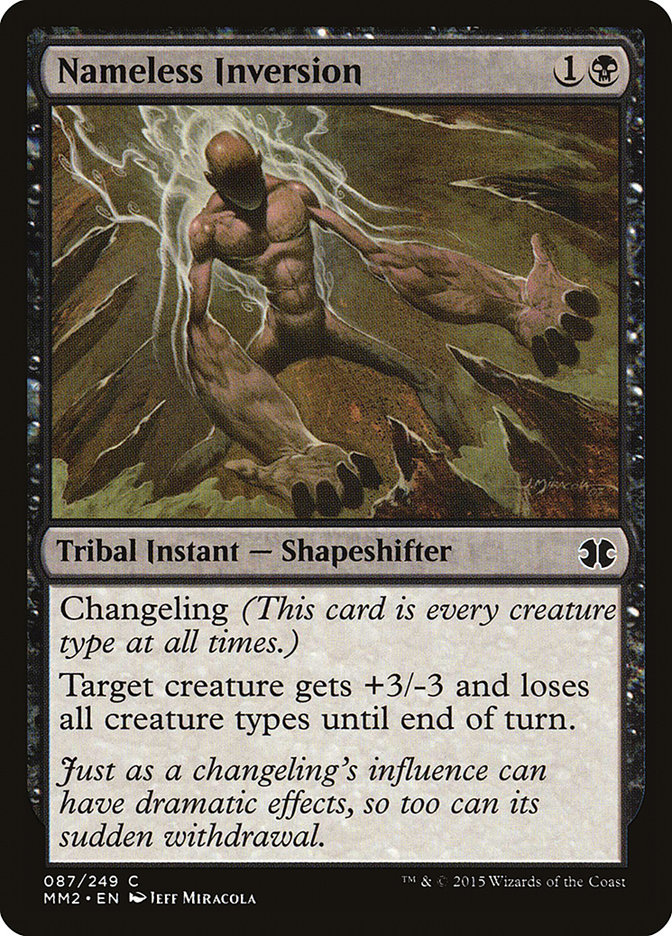Every time I look at the cards in Shadows over Innistrad the set gets more exciting. Just the right balance of awesome and subtlety.
— Ari Lax (@armlx) March 15, 2016
This statement still stands, but the “subtlety” aspect has some interesting results. There’s a lot of ways to work with all of the previewed cards from Shadows over Innistrad, and by virtue of how Magic works, some of those are dead ends on the way to the best deck. Or, just as likely, an important interaction that defines how a card is used is missed until that one person finds it, wins the event, and makes everyone else feel real silly for not noticing it earlier.
Through the early spoiler season, these are the common missed paths and mistakes I’ve noticed.
Everyone is trying to “build around” Archangel Avacyn. All these sacrifice outlets, Eldrazi Displacer, and so on. Here is how you build around Archangel Avacyn:
52 other good Magic cards
Archangel Avacyn doesn’t need help to be good. Honestly, the card would still be format-defining if it didn’t have a back side. I thought it was format-defining for weeks where I literally forgot it also had vigilance. The Eldrazi Displacer interaction is exciting simply because Eldrazi Displacer is another really good card. Sure, Ayli, Eternal Pilgrim is a fine card, but four copies of it is crazy.
Stop putting bad cards into your deck to make the best card in the set better. It doesn’t need the help. Just cast Archangel Avacyn and beat people because their cards are bad and yours are great.
To quote Gerry Thompson last week:
“‘Make a Wolf, Lightning Bolt something, make a Wolf, mini-Overrun’ looks like it will be a common play pattern.”
To quote me last week:
“Arlinn Kord has this great flip sequence”. Yes, your Planeswalker being in play for 4 turns should be good.
— Ari Lax (@armlx) March 18, 2016
People are getting too cute with how they are evaluating Arlinn Kord. If a planeswalker stays on the battlefield for multiple turns and isn’t absolutely dominating the game, it is probably just a bad card. In real life, your Arlinn Kord activations are going to diverge too much from a script due to pressure from creatures and interaction.
The key in determining if she is just an average threat or really great is locked up in the first turn or two. How much is a Wolf into a Lightning Bolt going to take over a game? If the 2/2 doesn’t matter and the relevant damage threshold of the format is four, Arlinn is not going to be more than another four-drop. If creatures are on the smaller side, Arlinn is going to dominate.
If anything, Arlinn Kord is going to underperform in the unopposed scenarios because it flips. Sometimes the Wolf token is a blank and you are waiting on enough Lightning Bolts to kill them, or you just want to produce threats and can’t spam Wolf tokens the way Xenagos, the Reveler buried control decks. Alternating Wolf into Bolt is still going to be good, but it is going to be easier to navigate out of because it doesn’t hammer hard on any specific axis.
I think the big matchup that is going to define Arlinn Kord’s tenure in this Standard format is whether she wins the heads-up fight against Gideon, Ally of Zendikar on turn 4. Obviously whoever is on the play is a massive favorite as they activate first and then get to attack with a 5/5 or Lightning Bolt, so it’s more about the odds of breaking serve than anything else. I think Arlinn’s plus abilities give her a bit of an edge, namely the line of “make Wolf token into give everything trample,” but Gideon is definitely a straight-up better card in a better color. As much as Arlinn has good sequences, Gideon into Archangel Avacyn is probably a better one.
Epiphany at the Drownyard is Steam Augury, not Fact or Fiction. I’ve seen many people go quickly from excited to disappointed when they realize this. Steam Augury wasn’t even playable, and this card costs six mana before it improves on that card. Don’t trick yourself into playing a bad card just because it claims to scale well, especially when the mechanics of the card minimize how much it gains with additional mana.
Don’t complain about the art on Sorin, Grim Nemesis looking like a bad metal album cover. Sorin is literally an ancient vampire from a horror world who fights Lovecraftian entities across the aeons. If that doesn’t sound like a concept album from the 1980s full of eight-minute guitar solos, I don’t know what does.
Also, there’s no need to clunk up your deck to make “+1: Draw a card with a bonus” good. Your opponent probably dies just fine to Sorin revealing normal spells instead of Ulamog, the Ceaseless Hunger.
I said a lot about Relentless Dead last week, but its use as a grindy single-card engine was only reinforced by how well looping it combines with Diregraf Colossus. The only problem might be that Nantuko Husk, Fleshbag Marauder, and Diregraf Colossus are all three-drops competing for the same curve space, along with Ruinous Path. Collected Company makes this a little more okay, as having tons of three-drops is now profitable, but you really can’t go much deeper on cards with that cost and still have a functional deck.
Olivia, Mobilized for War is not a good madness enabler. Again, we have people trying to be cute with a card you should just be playing straight-up. Olivia, Mobilized by War is going to excel in bulkier aggro decks, not B/R Vampire Madness shells.
The first issue here is that Olivia wants you spend mana to trigger the discard, or at least she does as long as good creatures still cost mana to cast. So you tap your lands to play your spell and then tap more lands to play your madness spell? Maybe you get to sneak in a Fiery Temper, but anything more expensive is just you playing awkwardly off-curve to get the “edge” of your madness spell costing less.
You can also look at this by breaking down her ability into parts.
Olivia, Mobilized for War gives you multiple historically powerful effects in one card, but only one of them fundamentally does what you want it to.
Glorious Anthems are best when they provide “haste” power by pumping creatures that are already on the battlefield and can attack. Olivia doesn’t do that. You play her and she is just a 3/3 flier that sits there for a turn. Mass pump is also good when providing card advantage by turning 1/1s into 2/2s. Turns out, having to discard cards negates any gains there. Madness still takes physical cards, and you will run out of good things to pitch before you can finish using Olivia on a bunch of smaller creatures.
The Fires of Yavimaya side works exactly as advertised, though. Curving Olivia, Mobilized for War into Thunderbreak Regent is most likely leading to a dead opponent on turn 5. There’s also some good old Philosophy of Fire here. If I use Olivia to make a two-drop have haste, I’m gaining three damage for my one card on that attack. If I make my four-drop have haste, that’s five or more damage. If I’m playing Olivia moving forward, it’s so I can just jam with giant four-drops on turn 4 and not to discard Incorrigible Youths while playing a one drop.
Falkenrath Gorger has a lot of the same issues as Olivia, Mobilized for War when you try to make a linear madness deck with it. All of the madness cards that have been historically good are things like Arrogant Wurm or Circular Logic, where you are playing discard outlets to reduce the cost of your spells. If your Vampires gain madness equal to their cost, your madness payoff has to be in what your discard outlets have to offer. The discard outlets spoiled to date aren’t exciting enough to want to go deep on that, and again, if you do, you have reliability issues in assembling both halves of the combo.
I just want to play this as a 2/1 with upside. There might be Heir of Falkenrath in my deck with Falkenrath Gorger, but that’s just because a 3/2 flying for two is fine. If I ever discard a Vampire that gained madness to make an Heir to the Night, that’s just an accidental bonus.
Everyone is rightfully excited about Drownyard Temple as a split card “land plus ramp spell,” but I’m interested in it in Eternal formats. Dredging up Drownyard Temple via Golgari Grave-Troll to rebuy Bloodghasts immediately seems better than having to wait a turn to dredge Dakmor Salvage or Life from the Loam to get going. I realize that costs mana the Dredge deck might not have, but in Modern this is a very reasonable way to make your deck more linear but still grindy.
I have no idea how people aren’t all over Sigarda, Heron’s Grace as one of the more powerful Standard cards in the set. It’s not quite Meloku, the Clouded Mirror, but it’s similar in application, a big flying threat that makes an army. As Siggy himself pointed out, it dodges a ton of removal by having two colors, flying, and five toughness. Green and white happen to be the same colors as Dromoka’s Command, which is one of the best multicolored payoffs left in the format.
She is also a combo with Gideon, Ally of Zendikar, but so is basically every good white card in the format.
Everyone’s first reaction when they saw Traverse the Ulvenwald had to have been, “Ooh, Modern creature combo.”
Except Traverse the Ulvenwald requires a complete rebuild of the creature combo archetype to work. Birthing Pod, Chord of Calling, and Collected Company all promote a drastically different shell from the delirium mechanic.
Look at the Abzan Company deck that I played at Pro Tour Oath of the Gatewatch or that Ralph Betesh won Grand Prix Detroit with. Or Jeff Hoogland’s Kiki-Chord deck.
Creatures (29)
- 4 Birds of Paradise
- 3 Eternal Witness
- 2 Wall of Roots
- 1 Orzhov Pontiff
- 4 Kitchen Finks
- 1 Murderous Redcap
- 3 Noble Hierarch
- 2 Viscera Seer
- 2 Spellskite
- 2 Melira, Sylvok Outcast
- 1 Fiend Hunter
- 2 Voice of Resurgence
- 2 Anafenza, Kin-Tree Spirit
Lands (23)
Spells (8)

Creatures (31)
- 4 Birds of Paradise
- 1 Kiki-Jiki, Mirror Breaker
- 2 Eternal Witness
- 3 Wall of Roots
- 1 Orzhov Pontiff
- 1 Big Game Hunter
- 1 Reveillark
- 1 Qasali Pridemage
- 1 Lone Missionary
- 3 Wall of Omens
- 1 Obstinate Baloth
- 1 Spellskite
- 1 Scavenging Ooze
- 3 Restoration Angel
- 3 Voice of Resurgence
- 2 Courser of Kruphix
- 2 Pia and Kiran Nalaar
Lands (23)
Spells (8)

These decks are very bad at getting delirium active because their other payoff cards make them build in the opposite direction. Collected Company and Chord of Calling want you to have a large number of creatures and very few instants and sorceries. Despite similar end goals, they don’t mesh with Traverse the Ulvenwald.
There’s also a problem with creatures or permanents in general in context of delirium, which is that they usually want to be on the battlefield and not in the graveyard. Land, instant, and sorcery going to your graveyard are givens, but you don’t want to rely on your opponent killing a creature for the last card type to make your card playable.
Traverse the Ulvenwald is going to work well alongside the following shell in Eternal formats:
There is some anti-synergy with milling your tutor targets with Thought Scour, but that’s what a card like Eternal Witness is for. These cards also push you towards Snapcaster Mage, which can be looped through a Traverse the Ulvenwald for a “free” 2/1 in late game scenarios. In terms of setting up a combo, you could just Pestermite – Kiki Jiki, Mirror Breaker, but there might be a pairing somewhere in the format that is slightly less efficient but with better individual cards.
You can also use Traverse the Ulvenwald as a slightly more flexible high-end threat in Jund or Abzan shells. Maybe you want an effective two copies of Olivia Voldaren in your deck but don’t really want to draw multiple copies of the actual card. Traverse the Ulvenwald does a good job of bridging the gap there, and Liliana of the Veil makes getting that fourth card type easy.
It is worth noting that more graveyard synergies pushes you away from delve and towards Dark Confidant. You can also find any land with a delirium Traverse the Ulvenwald, so you can toolbox up a Ghost Quarter if needed.
The Traverse the Ulvenwald shells are going to look a lot more like fair toolbox decks with a splash of combo than the full combo shells most people are expecting from the card.
One last note: Tribal is a card type. Nameless Inversion, then Traverse the Ulvenwald for a Haakon, Stromgald Scourge, anyone?
People’s immediate reaction to seeing the text box of this card is Storm-esque decks, but this is not a true Pyretic Ritual effect. If cast and activated on the same turn, you are not netting any mana.
The best comparison is Pentad Prism. In Modern, this isn’t going to work in the main Pentad Prism deck, as the Ad Nauseam – Angel’s Grace combo doesn’t want four red mana, but there is another Pentad Prism deck that could use that. Hive Mind wasn’t always just the backup plan for Amulet combo; it is an actual combo deck by itself. Importantly, it’s a combo that doesn’t really rely on the graveyard or a removable permanent, which is rare in Modern (their death is locked in as soon as you regain priority after resolving Hive Mind).
Vessel of Volatility lets Hive Mind replace Lotus Bloom with a more reliable card and enables more turn three kills with Simian Spirit Guide (why is that card still legal?). Here’s a sample all-in list, though a slightly more interactive one is likely better.
Creatures (6)
Lands (21)
Spells (33)

What about Standard? Early World Breaker and ramping to Ulamog, the Ceaseless Hunger is nice, but I want to point out that this is a way to get to delirium without relying on your opponent killing a permanent. Going back to Traverse the Ulvenwald, we may see that card and Vessel of Volatility become part of a slightly more aggressive Eldrazi Ramp deck moving forward.
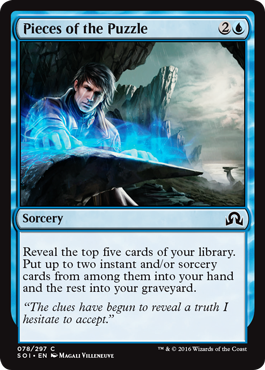
You need more instants and sorceries than you think to put Pieces of the Puzzle in your deck. Just like Collected Company, the goal is to really lock in hits and have selection. If the basic “two out of five” numbers are 24 spells to hit with Pieces in your deck, you probably want closer to 32 instants and sorceries for insurance. That really limits the number of creatures and planeswalkers you can play to win the game. If only there was some awesome spell to hit off Pieces of the Puzzle that won the game….
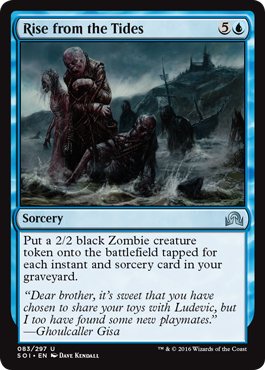
Yeah, there actually is one. I’m pretty sure that, since the Zombies enter the battlefield tapped, you need to be playing this card for around “one-shot lethal” for it to be great, but Rise from the Tides is definitely worth the six mana you pay for it.
Often, the synergies that define Standard are smaller than you think. Shadows over Innistrad has some linear cards, but it isn’t a linear set. It’s been a while since the obvious mechanically linear decks have ruled, and instead we see smaller packages of cards working well together defining the format. If you look at all the comments I made here, this is the consistent mistake people are making with this set. They are building as if these cards and mechanics are going to make the next Affinity deck when they couldn’t be further from it.
Go deep. Find the small synergies. Worst-case scenario, building the obvious linear deck is easy to do later. Finding the subtle things is what takes the most time and effort.



